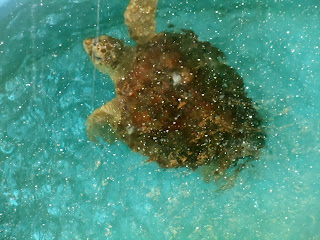Our time on Jekyll Island is about gone. We are leaving in a couple of days so this will be our last blog for a while. The pic below is of a little hermit crab without a shell. This one is pretty small; as they get bigger, they get bigger shells.
Island sunset, a beautiful and vibrant orange.
Our last trip around this area was to Okefenokee Swamp. One fine autumn day Brock and Leola and we hopped on the bikes for the 60 mile ride. A beautiful one coming and going.
Everywhere we've been on the east coast we've seen historical markers, but they are pretty much unreadable because they have no place to pull off to read them. This one was at the intersection of two busy roads. We were stopped at a light when I took this.
The Okefenokee is a National Parks site so the first thing we did at the visitors' center was to stamp our Passports. Then we browsed around the informative and very interactive displays soaking up information. After we watched the wonderful and awe-inspiring short film, we listened to this amazing robotic story teller.
The building also houses the gift center and a small short order eatery. We enjoyed our sandwiches and drinks, then took a boat ride into the Swamp. We were the only ones on the ride. Our guide was a local guy and very informative about the area. He was an expert gator spotter.
There were quite a few gators out sunning.
The Okefenokee is a wonderful place to canoe and kayak. There are miles of waterways and several places to (permit) camp for extended stays.
Fall colors were on display. The waterways ran through large areas of lily pads and bladder wort. The latter looks like root masses in the water.
These wonderful flowers were blooming everywhere. These are blooming on a floating mat of grasses. As the roots gather more soil and support more plants. As the plants die and decay, they form peat hummocks that gradually replace the open water.
Pulpit plants. These and the bladder wort are carnivorous.
Wonderful reflections. The water in the swamp is 98% pure from the surface down about 6 inches. All the plants on and in the water act as filters. A swamp is a place of standing water. If no rain falls, the swamp dries up.
Another fall bloomer. The berries on this shrub are poisonous. The native people used them as a purgative (in small quantities).
The other way to visit the swamp is by wheels along the nature drive. We failed to pick up a guide so we just made one stop.
Closeup beauty
The original boardwalk was destroyed in a wildfire. This new one is made from recycled plastic.
We walked to the end where there is a three story observation deck. We observed that we saw no wildlife. Too soon for migratory birds I guess. We did observe several bodies of water.
Yes we old people climbed this without stopping. We just kept telling ourselves that on the way back it was all downhill.
Brock and Leola are newlyweds. They just celebrated their 8th anniversary. Congrats!
We did see this white heron flying around.
Time for a pose with the bikes.
This completed the things we wanted to do in this area. We had a great time and the weather (and government) cooperated.
Tune in later for more adventures.
Louise and Duane






























































